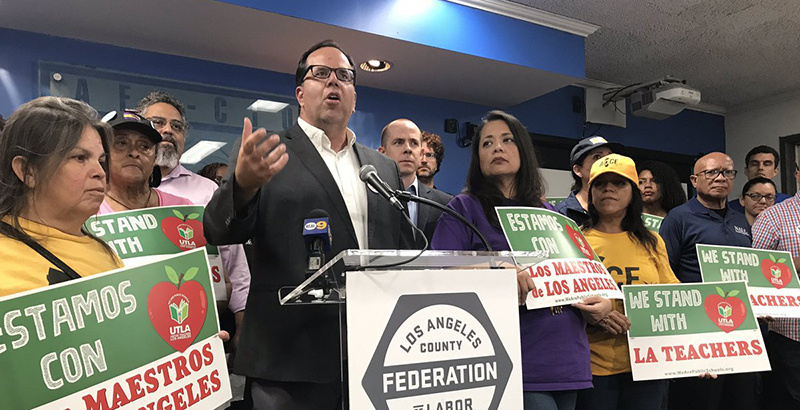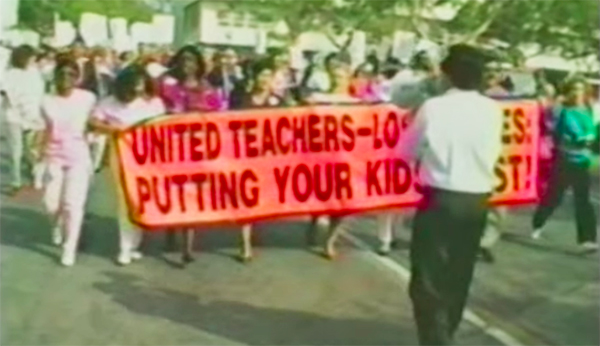With L.A. Bracing for Its First Teacher Strike in a Generation, Parents Feel ‘Stuck in the Middle,’ Worry Their Children Could Be Harmed by a Shutdown

As L.A. Unified and its teachers union ratchet up preparations for what is increasingly looking like the first teacher strike in 30 years, district parents are torn — and frustrated that the two sides can’t negotiate a solution.
While parents love and appreciate their teachers, they also don’t want their children’s education to be collateral damage in a fight among adults, they told LA School Report. Their top concerns during a strike are safety and the quality of classroom instruction.
United Teachers Los Angeles plans a January strike if no agreement is reached. More than 30,000 teachers across the district’s 1,100 public schools could participate, affecting more than 480,000 students in the country’s second-largest school district.
“At the end of the day, we don’t feel it’s fair to put parents in the middle,” said parent Kathy Kantner.
Parents don’t believe they’ve heard the whole story during the negotiations. L.A. Unified and UTLA have painted starkly different pictures of the district’s finances: District negotiators say accepting all of UTLA’s demands, which include higher salaries and lower class sizes, would “immediately bankrupt” the district and lead to teacher layoffs. UTLA says the district is overstating its financial woes and is “sitting on” money that is desperately needed in the schools.
“We need to be informed, and quite frankly, when it comes to the finances of the district, we don’t know,” said Evelyn Aleman, an LA Unified parent advocate.
Yet there seems to be little time to change course. L.A. Unified and UTLA last week completed the last stage of negotiations, known as “fact-finding,” and once a formal report is released by the panel’s mediator by Dec. 14, the union can legally call for a strike.
Parents have already seen pre-strike preparations underway for months. In early September, UTLA unanimously voted to transfer up to $3 million from its strike fund to its general fund for immediate use. Its social media channels regularly push out its hashtag #StrikeReady. Last Tuesday, it boycotted staff meetings at schools and handed out strike kits to its chapter chairs at more than 800 school sites. And over the weekend, it hosted an Art Build with students and teachers in preparation for this Saturday’s march in downtown Los Angeles.
TODAY: Strike kits distributed for every single chapter chair at over 800 school sites. GETTING MORE REAL. #StrikeReady #UnionOrganizerLife #UTLA @UTLAnow pic.twitter.com/rpgT8B3omR
— Jollene ?? (@jollenelevid) December 5, 2018
L.A. Unified, meanwhile, has distributed at least 115,000 copies of a parents guide called “Preparing for a Potential Strike.” It emphasizes that schools would remain open under the supervision of district staff and encourages parents to volunteer.
“All parents want to do is to not get the kids involved,” parent Geraldine Hernandez-Abisror said. “It’s like a divorce.”
Parents: “We feel torn”
Kantner loves her fifth-grade son’s teachers at Lanai Road Elementary School in Encino. And she acknowledges that “it’s the teachers’ right to strike.” But she also doesn’t want her district to fail.
“I have seen many of the district’s financial presentations, and the picture looks pretty grim,” said Kantner, a member of the Parent Community Sunshine Committee, which provides input to the district on labor contracts. “On the other hand, I have to say that I respect our teachers. My son loves his teachers, and he loves going to school. Parents like me, we feel torn.”
Laura Baz, another parent from the San Fernando Valley, said a strike “is not the best option for anybody, especially because it will harm the students immediately.” Baz has a ninth-grade son at Grover Cleveland Charter High School, a district-run affiliated charter. “But at the same time, I see how [teachers] work really hard for us and how working in the classroom with more students every year is not easy for them.”
Noriko Nakada, a teacher at Emerson Community Charter School, an affiliated charter middle school in Westwood, feels the strain of those large class sizes. She teaches two eighth-grade English classes with more than 40 students. The rest are in the high 30s.
“It’s just so hard to meet individual student needs when you have so many unique students in your class,” she said.
Though she’d plan to strike, Nakada said it’s not an optimal choice. “No teacher wants to leave their classroom or leave their students.”
When asked about their largest concerns with a teacher strike, parents emphasized safety — they want to know the adult-to-student ratio and how schools will keep students away from picketers — as well as the quality of instruction.
Research shows that students achievement suffers when teachers are absent — especially for extended periods of time. One study found that 10 days of teacher absence correlates with a student losing about six to 10 days of learning in English language arts and about 15 to 25 days in math.
“We won’t be happy if our kids are just going [to school] and watching videos all day,” Kantner said.
What would a strike look like?
When teachers walked out for the 1989 strike, which lasted nine days, widespread student absences followed. While schools stayed open, about 325,000 of the district’s 640,000 students skipped after the first day.

A high school junior during that strike recalled the experience in a 2011 blog post: “On that first day, I did report to school. We were sent to the library where we basically just sat around all day. There was nothing else to do. The next day, my parents provided me with a note saying that I didn’t have to be at school while the strike was going on.”
The district has studied that teacher strike as it crafts a game plan for January, a spokeswoman said by email.
If teachers walk out, school hours as well as morning and afterschool programs and meals “will not change,” according to the district’s parents guide. Any absences would count as unexcused absences, unless there’s “a justifiable personal reason” determined “on a case by case basis in alignment with District policy,” the spokeswoman wrote.
We have created the @LASchools Family Resource Guide with all the information you need to prepare in the event of a strike. We remain focused on keeping schools open and teaching our students. https://t.co/zEycHO3c3B pic.twitter.com/fsPp0hTVRr
— L.A. Unified (@LASchools) October 15, 2018
“Qualified L.A. Unified staff” would provide instruction, the guide states. That means staff with teaching credentials, such as former administrators, substitute teachers, counselors, and people from the central office, said Nick Melvoin, the school board’s vice president.
Class sizes, however, would probably grow temporarily. “The instructional structure will change, and may include an increase in class sizes across grade levels,” the spokeswoman wrote. L.A. Unified is “still working out” a possible cap on class sizes.
The district is encouraging parents to volunteer in the case of a strike. They need to be fingerprinted to volunteer in the schools, but they no longer have to pay a $56 fee.
Nakada, who has an elementary school daughter in the district herself, said it would be short-sighted to “think about the loss of three or four days as being more important than the educational needs of a city’s worth of students.”
She added that a work stoppage could even be a learning opportunity for students “in terms of long-term understanding of labor … and how collective bargaining works.”
At the Granada Hills Holiday Parade today, one memorable moment was the @UTLAnow teachers and supporters out w/ their signs! Very powerful! #StrikeReady #UTLAstrong pic.twitter.com/SeQPyhRhQ8
— Carlos Amador (@amadorlara) December 3, 2018
Melvoin said concerns about a strike have come up in almost all of the more than 60 meetings he’s had so far with parents this school year. He typically gets four to five emails a day from parents regarding the strike. On occasion, 30 to 40 emails flood his inbox.
A lot of those emails, especially recently, sound like this: “‘We know this is a state [funding] issue, and we know you have a tough job, but figure it out. This is on you and the union, and you need to figure it out,'” Melvoin said. He added, “I get that.”
Hernandez-Abisror, whose daughter is a second-grader at Encino Charter Elementary School, is struggling to wrap her head around the reality of a strike. Her family moved to L.A. Unified last year from Chicago, which narrowly avoided a teacher strike two years ago when her now 7-year-old was in kindergarten.
She asks herself: Why is this so hard for Los Angeles?
“Show our kids that two grown adults can figure a way to mediate and not let them be involved,” she said. “It boggles my mind.”
Two different realities
Parents aren’t only concerned about the learning implications of a strike. They are also exasperated that they’ve been left “in the dark” on where the district stands financially — and therefore have no way to help craft a solution, said Aleman, a parent advocate with a child at Grover Cleveland High School.
“If you’re reading a story with a quote from [the UTLA president] and you read a quote from the district, they don’t match,” she told LA School Report. “And I’m thinking, ‘Argh, I want to support teachers … but which side is telling the truth?’”
She added, “We need more information.”
The question of whether the district is healthy enough financially to meet UTLA’s demands has plagued contract negotiations since they began more than a year and a half ago.
County overseers have called L.A. Unified’s finances “alarming.” LA County’s chief financial officer, Candi Clark, warned the school board in August that it could install a fiscal adviser to take over the district’s finances. The district has until Dec. 17 to turn in an updated plan to address its structural deficit; then the county will decide whether or how to step in.
The district says it has an annual $500 million operating deficit, and its reserves are projected to drop to $700 million next fall — then to a bare $76.5 million in 2020-21. It lost about $630 million during the 2016-17 school year alone due to rising chronic absenteeism rates, and it loses millions more every year with district enrollment declining by at least 12,000 students annually. Student attendance largely determines how much money the district receives from the state.
All the while, incoming revenue will flatline if, as expected, the state ends its practice of sending the district one-time funds at the end of this year.
UTLA’s demands, including a 6.5 percent salary raise retroactive to July 2016, smaller class sizes, a full-time nurse for every district school and more special education teachers, would add an extra $813 million each year to the deficit, according to the district. Accepting those contract negotiations would wipe out L.A. Unified’s reserves in the 2018-19 school year, a July letter from district negotiators to UTLA stated.
“Data projections clearly show a structural and compounding annual deficit that threatens to overwhelm the core operations of the Los Angeles Unified School District,” a study released in June by the Reason Foundation, a right-leaning public policy research organization, found.
This is not a drill. We need to address @LASchools structural deficit or we’ll face massive layoffs, cuts to art, music & other classroom resources, taken away to pay for irresponsible financial decisions of the past.
We can’t afford to wait. #KidsFirst https://t.co/bY4Okxgmph
— Nick Melvoin (@nickmelvoin) November 15, 2018
Driving the union’s demands is its belief that L.A. Unified bears responsibility for the school system’s deficiencies. District policy allows middle and high school class sizes to creep into the 40s, for example — and the state already has one of the highest student-teacher ratios nationwide. There is “an absolute need to fix what we see every day: too many overcrowded classrooms where kids have to share desks, schools with a nurse only one day a week, and overloaded psychologists and counselors,” UTLA President Alex Caputo-Pearl told members in October.
The union claims that L.A. Unified’s “fiscal cliff” is an exaggeration. It points to the district’s own projections from two years ago of running out of cash by this year, and it maintains that the district is sitting on more than $1.8 billion in available reserves. L.A. Unified says that figure is outdated and that pot of money has already been budgeted over the next three years just to keep the district afloat.
UTLA did not respond to LA School Report’s requests for comment.
Nakada, the teacher from Westwood, said large class sizes can deter families, costing the district funding.
“When families come to us and talk to us about our school, the first question they ask is what the class sizes are,” Nakada said. “That’s a huge issue the district needs to address.”
L.A. Unified has offered to reduce class sizes, but only at 15 of the district’s highest-need middle schools and 75 of its highest-need elementary schools.
California ranks 48th out of 50 states in student-to-teacher ratios, and LAUSD teachers have among the largest class sizes in the state. Why won’t the district get rid of Section 1.5 of the UTLA-LAUSD contract, which allows LAUSD to raise class sizes across the district? pic.twitter.com/ms6wbJ50Br
— UTLA (@UTLAnow) October 12, 2018
Both sides also remain staunchly divided on topics such as teacher evaluations, charter schools, and testing. The district wants a teacher evaluation system with a “highly effective” category, which UTLA views as a pathway to tying pay to student performance. UTLA, respectively, seeks to restrict charter schools and give fewer standardized tests to students. Charter school expansion and non-state-mandated testing cost the district millions yearly, it’s said.
Melvoin said a former L.A. Unified superintendent called the district’s current offer of a 6 percent teachers raise over two years “already fatal.” And he cited Sacramento City Unified School District as a warning. That school district approved a teachers raise last November to avert a strike but is now slated to fall $66.5 million below minimum reserve requirements in 2020-21.
“I use [that example] to say to my colleagues and to parents: Maybe we could have avoided a strike if we just give in, but in two or three months, we’re going to have to issue thousands of layoff notices,” Melvoin said.
With the district’s finances a clear sore spot, Kantner wonders why the union and school leaders aren’t focusing their energy on the state capital, the main source of L.A. Unified’s funding.
“At the end of the day, we all want greater investment in our schools, but the district only gets the limited amount of money that it gets,” she said. “If we want more money, then the advocacy should take place in Sacramento.”
Parents should also be more included in the “critical” conversations impacting their children’s education — such as the district’s finances and the looming strike, Aleman said. Right now, they aren’t afforded “a significant seat at the table” on key committees and issues, she added.
“If the district were to support us so that we develop into a strong group of well-informed, proactive parent ambassadors capable of reaching across the aisle to move this process toward collaboration, and reaching out to lawmakers in Sacramento for increased funding, this could really benefit everyone,” Aleman said. “The district needs to move beyond parent engagement as a form of meeting compliance and instead look to us as partners.”
Melvoin agreed there should be more collaboration on what L.A. Unified and UTLA do agree on, such as wanting more money and more nurses. He said the district has funds set aside right now to add about 40 nurses, but a nursing shortage statewide has made hiring difficult.
“There’s some negotiating possible around the non-monetary items — like, let’s connect on a coalition to increase [state funding], or how do we really lower class size, or how do we work with medical schools and nursing schools to increase the pipeline of nurses,” he said. “If the two sides were talking, that’s where I think [progress] could come from.”
But his optimism has waned as UTLA has shown an “unwillingness to move,” he said. Both sides have accused each other of not bargaining in good faith.
Now, each day is just lost time, Melvoin said.
“The amount of time that people are talking about this … in faculty meetings, superintendent meetings, board meetings, board office meetings — it got to a point last week where I was incredibly frustrated,” he said. “All of this conversation is on strike prep when we have so much work to do for our kids.”
Esmeralda Fabían Romero contributed to this report.
Get stories like these delivered straight to your inbox. Sign up for The 74 Newsletter

;)
